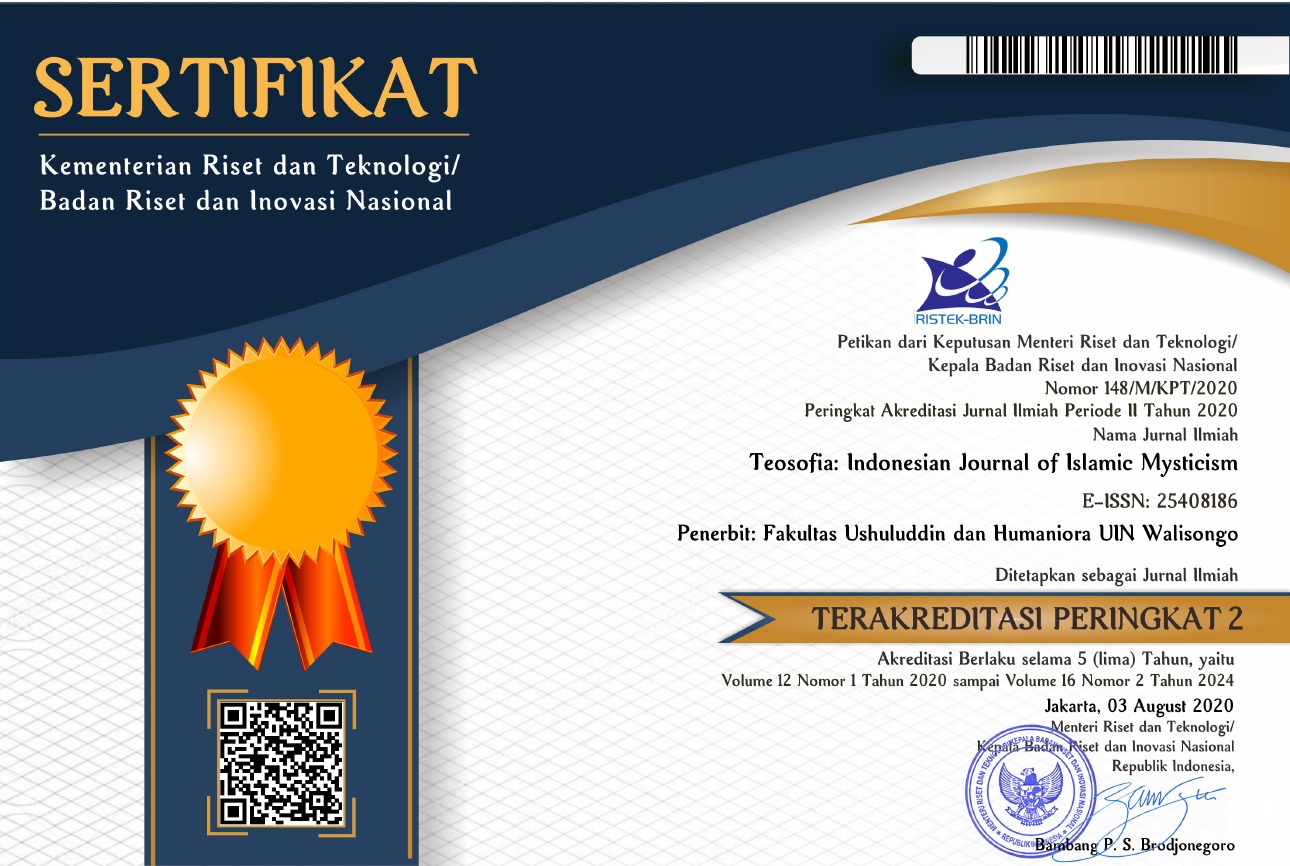Digital Media Impact on Sufi Practices: Analyzing Ijāza Wirid Dhikr
DOI:
https://doi.org/10.21580/tos.v13i1.20860Keywords:
sufi practices, digital media, ijāza, authenticityAbstract
This article discusses the impact of digital media on Sufi practices, specifically in the context of conducting ijāza (authorization) for wird dhikr rituals through digital platforms. Traditionally, Sufi practices such as the ijāza involve direct teaching from teacher to student. However, with the rapid development of digital media, the ijāza process has undergone significant changes. This study adopts an eclectic approach, which combines digital ethnography to study online participant engagement and a comprehensive literature review to track and measure the transformation of ijāza through digital media. Data were gathered from various sources, including books, scholarly journals, and relevant digital content related to the research topic. The findings show that the evolution of digital media has transformed the implementation of ijāza for wird dhikr from direct (traditional) to indirect transmission through online media, and it is considered valid. Yet, ijāza is not merely dealing with the process of authorization but also the transmission of blessings and spiritual knowledge from the teacher to the student, which needs close engagement and relationships that can only be achieved with direct interaction.
Contribution: This article provides an understanding of the impact and validity of ijāza conducted through digital media compared to traditional methods yet considered valid.
Downloads
References
Al-‘Iraqi, ‘Abd al-Raḥim bin al-Ḥusain. Al-Taqyīd Wa Al-Īḍāḥ Syarḥ Muqaddimāt. Beirut: Dār al-Fikr, 1981.
Al-Fayrūzabādī, Muhammad Bin Ya’qūb. Al-Qāmūs Al-Muhīt. Edited by M. Naim Al-Araqsusi. 3rd ed. Beirut: Muassasah al-Risālah, 1993.
Al-Nawawī, Abu Zakariya Yahya Ibn Syaraf. Al-Taqrīb Wa Al-Taysīr Li-Ma‛rifati Sunan Al-Bashīr Al-Nazīr. Beirut: Dar al-Kutub al-Arabi, 1985.
Al-Sakhāwī, Muḥammad bin ‘Abd al-Raḥmān. Fathu Al-Mughīs Bi Syarhi Alfiyyah Al-Hadīs. Edited by Ali Husain. Vol. 2. Cairo: Maktabah al-Sunnah, 2003.
Al-Shahrazūrī, ‘Uthmān bin ‘Abd al-Raḥmān Ibn Ṣalāḥ. Ma‘rifatu Anwāu‘ Ulūmi Al-Ḥadīts. Beirut: Dār al-Fikr al-Mu‘āṣir, 1986.
Al-Suyūṭī, Jalāluddīn. Tadrību Al-Rāwī Fī Syarḥi Taqrībi Al-Nawāwī. Beirut: Dār al-Kutubi al-Islāmiy, 1996.
Ar-Ramahurmuzi, Ibn Khallad. -Muhaddits Al-Fāsil Baina Al-Rāwi Wa Al-Wā’iy. Cairo: Dār al-Dzakhāir, 2016.
Badaruddin, Faudzinaim, and Muhammad Khairi Mahyuddin. “The Authority of Chain of Transmission and Its Role in Sufism.” International Journal of Islamic Thought 2, no. 2 (2021): 34–44. https://www.ukm.my/ijit/wp-content/uploads/2021/11/Faudzinaim-IJIT-Vol-20-Dec-2021.pdf.
Baker, Lynda. “Observation: A Complex Research Method.” Library Trends 55, no. 1 (June 2006): 171–89. https://doi.org/10.1353/lib.2006.0045.
Bellar, Wendi. “Rituals: Prayer App Rituals.” In Digital Religion: Understanding Religious Practice in Digital Media, edited by Heidi A. Campbell and Ruth Tsuria. London: Routledge, 2021.
Campbell, Heidi A., and Ruth Tsuria. Digital Religion. London: Routledge, 2021. https://doi.org/10.4324/9780429295683.
Cox, Laurence, Anna Szolucha, Alberto Arribas Lozano, and Sutapa Chattopadhyay, eds. Handbook of Research Methods and Applications for Social Movements. Northampton: Edward Elgar Publishing, 2004.
Eisenlohr, Patrick. “Media and Religious Diversity.” Annual Review of Anthropology 41, no. 1 (October 21, 2012): 37–55. https://doi.org/10.1146/annurev-anthro-092611-145823.
Enjolras, Bernard, and Kari Steen-Johnsen. “The Digital Transformation of the Political Public Sphere: A Sociological Perspective.” In Institutional Change in the Public Sphere: Views on the Nordic Model, edited by Fredrik Engelstad, Håkon Larsen, Jon Rogstad, and Kari Steen-Johnsen, 99–117. Warsaw/Berlin: De Gruyter Open Ltd, 2017. https://doi.org/10.1515/9783110546330-006.
Fader, Ayala, and Owen Gottlieb. “Occupy Judaism: Religion, Digital Media, and the Public Sphere.” Anthropological Quarterly 88, no. 3 (June 2015): 759–93. https://doi.org/10.1353/anq.2015.0032.
Isiko, Alexander P. “Association for the Study of Religion in Southern Africa (ASRSA) Covid-19 and Its Impact on Religiosity.” Source: Journal for the Study of Religion 35, no. 1 (2022): 1–32. https://doi.org/10.2307/27203192.
Lundby, Knut. “Public Religion in Mediatized Transformations.” In Institutional Change in the Public Sphere, 241–63. De Gruyter Open, 2017. https://doi.org/10.1515/9783110546330-013.
Majlis Tadzkir Lombok. “Ijazah Wirid from Sheikh Abdul Qadir Al-Jilani!!! Langsung Dari Cucu Beliau.” YouTube Video, 2023. https://www.youtube.com/watch?v=fFK3wvsnknk.
Manzūr, Ibn. Lisān Al-‛Arab. Vol. 1. Beirut: Dār al-Ihyā at-Turāts, 1970.
Nasidi, Nadir A. “A Contextual Analysis of Sacred Qādiriyyah Sufi Paintings in Kano, Nigeria.” Vestiges: Traces of Record 6 (2020): 47–63. https://www.vestiges-journal.info/2020/nasidi_2020.html.
Thalhān, Mahmūd. Taisīr Musthalah Al-Hadīts. Riyadh: Maktabah al-Ma’ārif, 1987.
Thornhill, David S. “Best Leadership Practices of Senior Pastors in The Church of The Nazarene.” Olivet Nazarene University, Illinois, 2023. https://www.jstor.org/stable/community.36627889.
Yurnalis, Syukri Al Fauzi Harlis, Endrika Widdia Putri, and Arrasyid. “Urban Sufism from Exclusiveness to Inclusiveness: A Metaphysical Perspective.” Teosofia: Indonesian Journal of Islamic Mysticism 11, no. 2 (2022): 183–202. https://doi.org/10.21580/tos.v11i2.14522.
Downloads
Published
How to Cite
Issue
Section
License
Copyright
The copyright of the received article shall be assigned to the journal as the publisher of the journal. The intended copyright includes the right to publish the article in various forms (including reprints). The journal maintains the publishing rights to the published articles. Therefore, the author must submit a statement of the Copyright Transfer Agreement.*)
Licensing

This work is licensed under a Creative Commons Attribution-ShareAlike 4.0 International License.
In line with the license, authors are allowed to share and adapt the material. In addition, the material must be given appropriate credit, provided with a link to the license, and indicated if changes were made. If authors remix, transform or build upon the material, authors must distribute their contributions under the same license as the original.
_______
*) Authors whose articles are accepted for publication will receive confirmation via email and send a Copyright Transfer Agreement.








